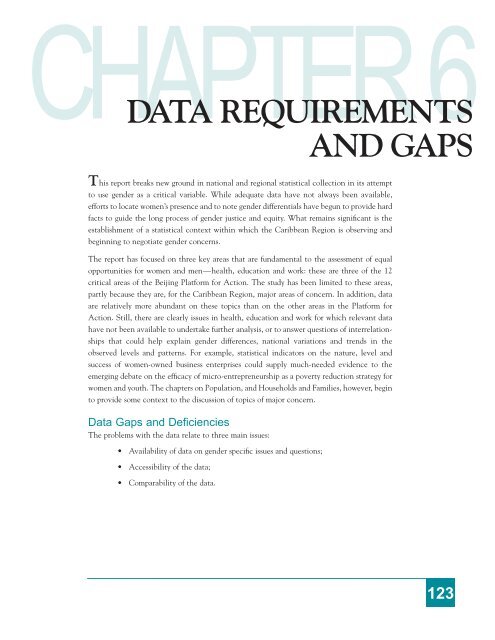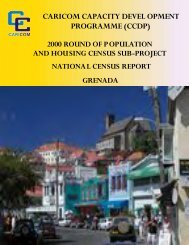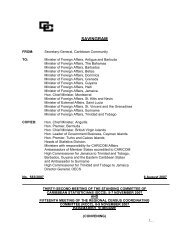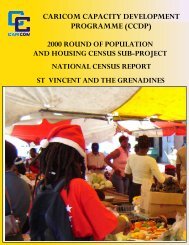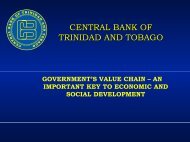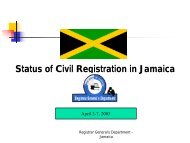<strong>Women</strong> <strong>and</strong> <strong>Men</strong> <strong>in</strong> <strong>the</strong> <strong>Caribbean</strong> <strong>Community</strong>Table 5.25 Mean monthly <strong>in</strong>come of <strong>the</strong> employed population by occupational group,Tr<strong>in</strong>idad <strong>and</strong> Tobago, 1990 <strong>and</strong> 1997Mean monthly <strong>in</strong>come1990 1997Occupational Group<strong>Women</strong> <strong>Men</strong>Ratio ofW/M <strong>Women</strong> <strong>Men</strong>Ratio ofW/MClerks 1,800 2,000 90 2,000 2,200 91Architects, eng<strong>in</strong>eers <strong>and</strong> related technicians 2,100 2,600 81 2,900 3,400 85Professionals 3,100 4,000 78 4,800 5,900 81Elementary occupations 700 1,000 70 800 1,300 62Adm<strong>in</strong>istrative <strong>and</strong> managerial workers 1,700 2,700 63 2,200 3,900 56Craft <strong>and</strong> related workers 800 1,300 62 800 1,700 47Agricultural, forestry <strong>and</strong> fishery workers 500 900 56 700 1,100 64Plant <strong>and</strong> mach<strong>in</strong>e operators <strong>and</strong> assemblers 1,000 1,800 56 1,000 2,000 50Service (<strong>in</strong>cl. Armed/Defense force), shop <strong>and</strong>market sales workers900 4,000 23 1,100 2,100 52Source: Based on data compiled by <strong>the</strong> CARICOM Secretariat from national labour force reports <strong>and</strong>data submitted by Member States.<strong>Women</strong> Earn Less than <strong>Men</strong> but Wage Gap Least among Paid Employees<strong>Women</strong> employers did far worse than any o<strong>the</strong>r category relative to men: <strong>the</strong>y earned an average<strong>in</strong>come of 38 per cent of what men earned <strong>in</strong> 1990. However, <strong>the</strong>ir earn<strong>in</strong>gs improvedsubstantially relative to men, earn<strong>in</strong>g about 77 per cent of what men earned <strong>in</strong> 1997. In <strong>the</strong>o<strong>the</strong>r statuses—paid employee <strong>and</strong> own-account worker—women’s average <strong>in</strong>come<strong>in</strong>creased, but by proportionately less than men’s. Therefore, <strong>the</strong> ratio of women’s to men’s<strong>in</strong>come also decl<strong>in</strong>ed. S<strong>in</strong>ce employers <strong>and</strong> own-account workers are <strong>in</strong>dependent workers,operat<strong>in</strong>g <strong>the</strong>ir own bus<strong>in</strong>esses, this difference <strong>in</strong> <strong>in</strong>come is a reflection of how well women’senterprises do, compared with those of men (table 5.26). The relative lack of success ofwomen’s enterprises may be directly l<strong>in</strong>ked to <strong>the</strong>ir <strong>in</strong>ability to access support, such as credit,technical assistance, management tra<strong>in</strong><strong>in</strong>g, etc., as well as compet<strong>in</strong>g dem<strong>and</strong>s on <strong>the</strong>ir timeof domestic duties.Table 5.26 Mean <strong>in</strong>come by status <strong>in</strong> employment, Tr<strong>in</strong>idad <strong>and</strong> Tobago, 1990 <strong>and</strong> 1997Mean (TT$)1990 1997RatioRatioStatus <strong>in</strong> employment <strong>Women</strong> <strong>Men</strong> W/M <strong>Women</strong> <strong>Men</strong> W/MPaid employee 1,600 1,800 89 1,900 2,200 86Employer 900 2,400 38 2,400 3,100 77Own-account worker 700 900 78 900 1,300 69All statuses 1,400 1,600 88 1,700 2,000 85Source: Cont<strong>in</strong>uous Sample Survey of Population (CSSP) Labour force Report 1992,table 36, pages 112-114; <strong>and</strong> CSSP Labour force report 1997 table 7, pages 170-173.122
CHAPTER 6DATA REQUIREMENTSAND GAPSThis report breaks new ground <strong>in</strong> national <strong>and</strong> regional statistical collection <strong>in</strong> its attemptto use gender as a critical variable. While adequate data have not always been available,efforts to locate women’s presence <strong>and</strong> to note gender differentials have begun to provide hardfacts to guide <strong>the</strong> long process of gender justice <strong>and</strong> equity. What rema<strong>in</strong>s significant is <strong>the</strong>establishment of a statistical context with<strong>in</strong> which <strong>the</strong> <strong>Caribbean</strong> Region is observ<strong>in</strong>g <strong>and</strong>beg<strong>in</strong>n<strong>in</strong>g to negotiate gender concerns.The report has focused on three key areas that are fundamental to <strong>the</strong> assessment of equalopportunities for women <strong>and</strong> men—health, education <strong>and</strong> work: <strong>the</strong>se are three of <strong>the</strong> 12critical areas of <strong>the</strong> Beij<strong>in</strong>g Platform for Action. The study has been limited to <strong>the</strong>se areas,partly because <strong>the</strong>y are, for <strong>the</strong> <strong>Caribbean</strong> Region, major areas of concern. In addition, dataare relatively more abundant on <strong>the</strong>se topics than on <strong>the</strong> o<strong>the</strong>r areas <strong>in</strong> <strong>the</strong> Platform forAction. Still, <strong>the</strong>re are clearly issues <strong>in</strong> health, education <strong>and</strong> work for which relevant datahave not been available to undertake fur<strong>the</strong>r analysis, or to answer questions of <strong>in</strong>terrelationshipsthat could help expla<strong>in</strong> gender differences, national variations <strong>and</strong> trends <strong>in</strong> <strong>the</strong>observed levels <strong>and</strong> patterns. For example, statistical <strong>in</strong>dicators on <strong>the</strong> nature, level <strong>and</strong>success of women-owned bus<strong>in</strong>ess enterprises could supply much-needed evidence to <strong>the</strong>emerg<strong>in</strong>g debate on <strong>the</strong> efficacy of micro-entrepreneurship as a poverty reduction strategy forwomen <strong>and</strong> youth. The chapters on Population, <strong>and</strong> Households <strong>and</strong> Families, however, beg<strong>in</strong>to provide some context to <strong>the</strong> discussion of topics of major concern.Data Gaps <strong>and</strong> DeficienciesThe problems with <strong>the</strong> data relate to three ma<strong>in</strong> issues:• Availability of data on gender specific issues <strong>and</strong> questions;• Accessibility of <strong>the</strong> data;• Comparability of <strong>the</strong> data.123


